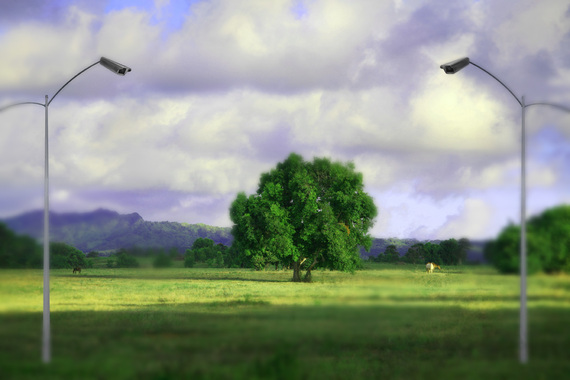The concept of surveillance is ingrained in our beings. God was the original surveillance camera.
- HASAN M. ELAHI
They are intent on making every conversation and every form of behavior in the world known to them.
- EDWARD SNOWDEN
You only need sit still long enough in some attractive spot in the woods that all its inhabitants may exhibit themselves to you by turns.
- HENRY DAVID THOREAU
The NATURAL SECURITY photography project evolved as a result of the artists' fascination with the conflicts and complexities in the interaction between natural landscapes and humanity, and the untenable belief that man can control everything -- including nature itself. The individual titles of the seven large-scale photographs in the series are geographical coordinates that can be entered into Google Earth to show the remote locations in which the original images were captured. And indeed the ease with which that geo-location tagging can be accomplished and the data embedded into the digital image file even without the author's knowledge was itself partly responsible for the suspicious epiphany that prompted the series. But for the most part, it was simply their keen insights into human history, and an engagement with the shifting terrain of the global surveillance industry, that first made them wonder whether the trees might indeed be staring back.
Presenting an aesthetic juxtaposition of remote camera-based surveillance within the framework of traditional landscape photography creates more than a cognitive dissonance. While absorbing these large-scale, borderline kitsch images of wild paradise, lush verdancy, majestic sunsets, and fairy tale romance, there inevitably comes that shocking instant when the viewer realizes the cameras are there. It's startling; there's a primal emotional reaction which for some is laughter, for others, audible gasps and intense unease. Of course, this is what happens in real life and on news networks all the time now. It's the same collective gasp heard when folks first got the news about Snowden's revelations, and the same gasp that Snowden emitted when he first understood what lay before him. Even with the series title, there's a double take in getting the pun. This affecting juxtaposition is exaggerated by the extreme beauty of the settings and the expectation that such remote corners of the world are free from the ubiquitous surveillance mechanisms we have come to expect in our towns and cities. Beginning in 2011, during the time it took to finish, this idea that began as gentle and presciently cautionary satire had become a familiar and unsettling fact. Remember, the Edward Snowden leaks happened in 2013 -- nearly two years into the production process on Natural Security. "Orwell wrote science fiction; and [the secret government data-mining operation] Echelon was dismissed as paranoia -- but Snowden is just reality."
Of course the works are finished using digital manipulation; meticulously conceived and crafted, they are rendered with convincing realism despite the occasional visual clue deliberately left in -- an unfinished edge, a pixelated bit of atmosphere, a tweaked shadow. Still, whether by a trick of the optic nerve or a by-product of news-cycle saturation, people often believe it's either real or quite possible that such an extensive yet unlikely camera network might actually exist. In the jungle piece, the cameras follow the viewer throughout the room, like the Mona Lisa's eyes. In the pond piece, the cameras look like faux-arbor cell towers; in the beachfront piece they look like lampposts. The one in Kauai depicts a famous tourist spot, so it's a bit meta, being that so many people take and post and tag photographs there as it is. The lone tree image is composed like a regal Corot, the cameras looking like floodlights on a rural sports field; the sunset piece shows the equipment in classic postcard-style silhouette; while the piece with the pair of intertwined trees adds a more overtly humorous aspect -- because their trunks look like a fornicating couple, watching you watching them.
In Europe and elsewhere performance artists have done things like holding up subversive written signs and acting out plays in front of municipal cameras. Wildlife research cameras have been hijacked by artists, or else have accidentally captured the actions of unsuspecting people who thought they had found privacy in a remote public place, like a park or the forest. This is of course, hilarious, and in a way, the cheekiest promises of the internet are fulfilled by such shenanigans. But then again, if we laugh about it, we don't have to admit how serious it is. And maybe that's what people want. Based as they are on serene, conventional, and plainly beautiful concepts of landscape, with Natural Security it's still perfectly possible to choose to ignore the cameras and just enjoy the gorgeous pictures. This is analogous what we do as we act out our own complicity and with systems like Facebook and Google -- through our tacit approval we become active participants in our own oppression. This is tomorrow's world, set in today's environment -- but if nature truly is our mirror, then gazing at images like these can show us a lot about who and how we really are.
All Images: Laura & Manfred Menz (2013). Courtesy of Baik Art.



